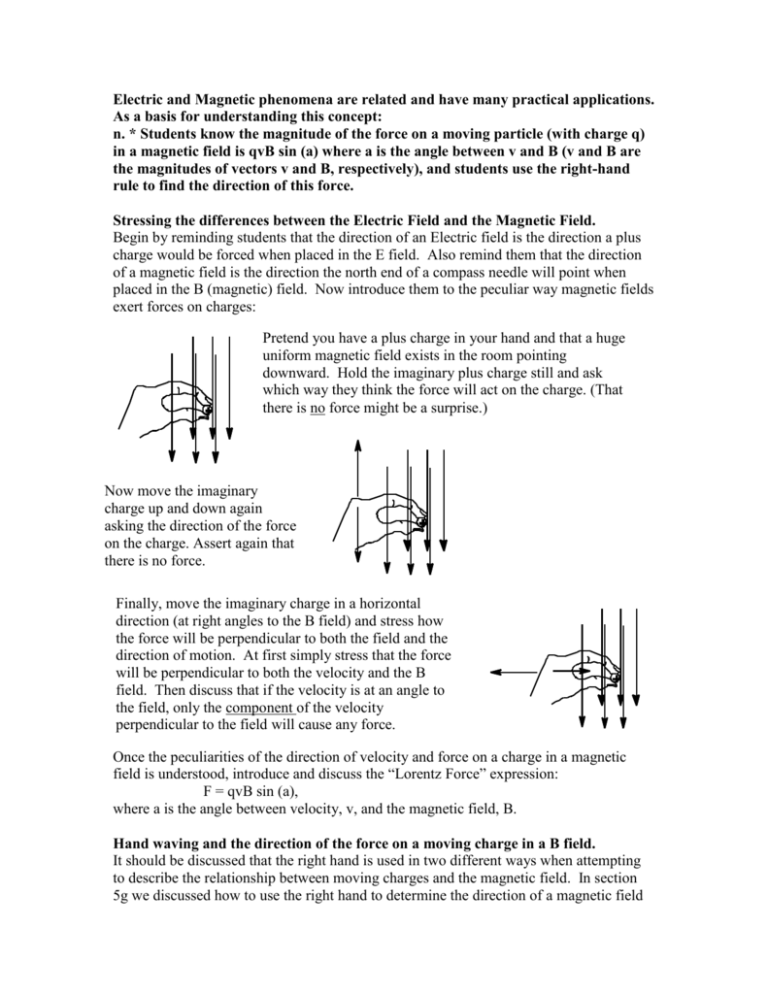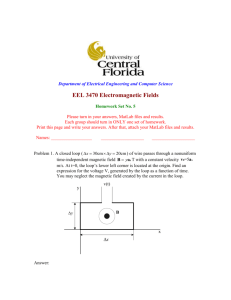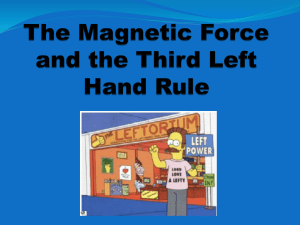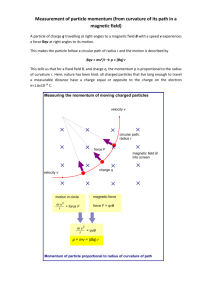Electric and Magnetic phenomena are related and have many
advertisement

Electric and Magnetic phenomena are related and have many practical applications. As a basis for understanding this concept: n. * Students know the magnitude of the force on a moving particle (with charge q) in a magnetic field is qvB sin (a) where a is the angle between v and B (v and B are the magnitudes of vectors v and B, respectively), and students use the right-hand rule to find the direction of this force. Stressing the differences between the Electric Field and the Magnetic Field. Begin by reminding students that the direction of an Electric field is the direction a plus charge would be forced when placed in the E field. Also remind them that the direction of a magnetic field is the direction the north end of a compass needle will point when placed in the B (magnetic) field. Now introduce them to the peculiar way magnetic fields exert forces on charges: Pretend you have a plus charge in your hand and that a huge uniform magnetic field exists in the room pointing downward. Hold the imaginary plus charge still and ask which way they think the force will act on the charge. (That there is no force might be a surprise.) Now move the imaginary charge up and down again asking the direction of the force on the charge. Assert again that there is no force. Finally, move the imaginary charge in a horizontal direction (at right angles to the B field) and stress how the force will be perpendicular to both the field and the direction of motion. At first simply stress that the force will be perpendicular to both the velocity and the B field. Then discuss that if the velocity is at an angle to the field, only the component of the velocity perpendicular to the field will cause any force. Once the peculiarities of the direction of velocity and force on a charge in a magnetic field is understood, introduce and discuss the “Lorentz Force” expression: F = qvB sin (a), where a is the angle between velocity, v, and the magnetic field, B. Hand waving and the direction of the force on a moving charge in a B field. It should be discussed that the right hand is used in two different ways when attempting to describe the relationship between moving charges and the magnetic field. In section 5g we discussed how to use the right hand to determine the direction of a magnetic field that resulted from a current (or a moving charge.) Now we assume the magnetic field already exists and we will be using the right hand to find the direction of the force on a charge moving through the field. This can easily confuse students if the two different uses of the right hand rule are not discussed. There are several different ways of stating this mnemonic but we like the following called the “flat hand rule” to distinguish it from the “curled finger rule” previously used to describe the magnetic field around a current. The field, B, velocity, V and force F form a threedimensional coordinate system. The palm of your (flat) right hand is used to push things; hence it is logical to have it represent the direction of the force. When you thumb a ride, you point your thumb in the direction of your intended velocity; hence the direction of your thumb is the direction of the velocity. Finally, your fingers (begins with “f”) point in the direction of the Field. Hence fingers in the direction of the field, thumb in the direction of velocity and palm in the direction of force describe a positive charge moving through a magnetic field. If the charge is negative, use the left hand. B V F Demonstration to illustrate how moving charges are affected by B fields: Illustrated on the left is a demonstration that can effectively show the direction of the Lorentz force. It requires a strong magnet and a power supply that can produce a short burst of current in the 10-amp range. The suspended loop of wire is bent so a horizontal section passes through the most intense region of the magnetic field. The suspended wire is supported by a wooden dowel that has been drilled to pass the wire enabling easy connection of the power supply leads with clips. The dowel is supported by a ring stand and the magnet should be firmly held so it won’t move. Changing the clips can easily reverse direction of the current. Using a compass needle determine the direction of the magnetic field of the magnet. Knowing the polarity of the power connections, the direction of the current will be known. Before you momentarily turn on the power, have the students use the right hand rule to predict the direction the will move in the field. After the first demonstration, perhaps reverse the direction of the current and/or turn the magnet upside down. The units of electric field intensity, E and magnetic field intensity, B: The electric field intensity is defined by: E = F/q and the electric field intensity unit has no special name. It is simply a Newton/Coulomb. However, the unit of magnetic field intensity is the Tesla. If a charge of one Coulomb moves at a velocity of one meter per second at right angles to a magnetic field of one Tesla, it will experience a force of one Newton. Using the Lorentz force expression gives B = F/qv = N/Cm s-1 = N-s/C-m or one Tesla = one Newton sec/Coulomb-meter. (There are several other names for the unit of magnetic field intensity and they all mean the same thing. These are given here just for reference: Tesla= Weber/m2 = Newton/amp-meter. A common unit of magnetic field intensity is the Gauss. One Tesla = 104 Gauss. The intensity of the earth’s magnetic field at the earth’s surface is about one half a Gauss.) How charged particles move in E fields and B fields: When charged particles move through E fields, the force on the charge can change its direction as well as speed it up or slow it down. However, since a B field can only exert a force on the moving charge at right angles to its motion, the B field can only change the direction of the particles motion. Consider the difference between the motion of a positive charge entering an E field at right angles to the field and the same charge entering a B field at right angles to the field. When a charged particle enters an E field at right angles to the field, the force on the particle will accelerate it in the direction of the field (if it is positive) and it will both turn and speed up. The particle will assume a parabolic path in much the same way that a rock thrown at right angles to a gravitational field moves in a parabolic path. When a charged particle enters a B field at right angles to the field, the only force on the particle is always at right angles to the particle’s motion, hence it will move in a circle until it is no longer in the field. It will not speed up or slow down. Should the particle be fired at an angle to the field, it will move in a helical path. If a charged particle is fired within a magnetic field at right angles to the field, it can move in a complete circle. If it is fired at an angle to the field and remains within the field, it will move in a helix. The component of the velocity parallel to the field will advance the particle and the component of the velocity perpendicular to the field will determine the radius of the helix. Finally, magnetic fields can not do work on free charge particles, hence they can not speed them up or slow them down (that is, change their kinetic energy. If the kinetic or potential energy of a charge changes, it probably was due to an electric field and certainly was not due to a magnetic field.









